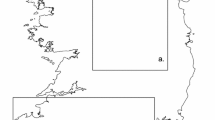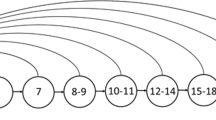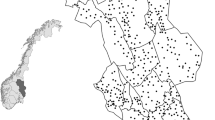Abstract
There is growing concern about the spread of the North American grey squirrel (Sciurus carolinensis) in northern Italy which were introduced into Piedmont in 1948. They have since spread across the Po-plain covering an area of approximately 450 km2 and continue to expand their range. In parallel to what has been observed in Britain and Ireland, grey squirrels replace the native red squirrel (S. vulgaris) and damage poplar (Populus) plantations through bark-stripping. Spatially explicit population dynamics models have been successfully used to predict the spread of grey squirrels in East Anglia, England. We extended a previous approach employing a sensitivity analysis where life history and other demographic inputs are generated using Latin Hypercube Sampling from the known ranges of each input parameter, and applied it to Italy using field data collected in Piedmont. The analysis indicated that reproductive output was the most important factor determining total population size present in Piedmont. The structure and composition of woodland habitats around the introduction site suggested that initial grey squirrel expansion would have been slow and subject to emigration rates from the available habitat blocks.
A comparison of the 1996 survey results with model predictions indicated that a mean litter size of three young gave the best fit with the observed distribution and we use this to predict future grey squirrel spread. We also present a ‘worst case’ scenario in which grey squirrels experience improved reproductive success due to the availability of high quality habitats beyond the Po plain. In both cases they could disperse along existing continuous woodland corridors into France between 2039–2048. The case of the grey squirrel highlights the problems of implementing conservation conventions and the resulting conflicts between wildlife management, public perception and local political support and the narrow time frame that is available to control alien species effectively before it is too late. If allowed to spread, grey squirrels have the potential of becoming a European forest pest species and are likely to replace the native red squirrel in large parts of its range.
Similar content being viewed by others
References
Adrén, H. 1994. Effects of habitat framentation on birds and mammals in landscapes with different proportions of suitable habitat: a review. Oikos 71: 355–366.
Andrén, H. and Delin, A. 1994. Habitat selection in the Eurasian red squirrel, Sciurus vulgaris, in relation to forest fragmentation. Oikos 70: 43–48.
Barreto, G.R., Rushton, S.P., Strachan, R. and Macdonald, D.W. 1998. The role of habitat and mink predation in determining the status and distribution of water voles in England. Animal Cons. 1: 129–137.
Bart, J. 1995. Acceptance criteria for using individual-based models to make management decisions. Eco. Appl. 5: 411–420.
Bertolino, S. 1999. Vertebrate fauna introduced in Piedmont (Osteichthyes, Amphibia, Reptilia, Aves, Mammalia). Riv. Piem. St. Nat. 20: 215–240 (in Italian).
Celada, C., Bogliani, G., Gariboldi, A. and Maracci, A. 1994. Occupancy of isolated woodlots by the red squirrel Sciurus vulgaris L. in Italy. Biol. Cons. 69: 177–183.
Chitty, D. 1996. Do lemmings commit suicide? Oxford University Press, Oxford, UK.
Currado, I. 1998. The gray squirrel (Sciurus carolinensis Gmelin) in Italy: a potential problem for the entire European continent. In Ecology and Evolutionary Biology of Three Squirrels. pp. 263–266. Edited by M.A. Steel, J.F. Merritt, and D.A. Zegers. Special Publication Virginia Museum of Natural History 6, Martinsville, VA, USA.
Currado, I., Scaramozzino, P.L. and Brussino, G. 1987. Note sulla presenza dello scoiattolo grigio (Sciurus carolinensis Gmelin) in Piemonte. Annali della Facolta di Scienze Agrarie della Universita di Torino 14: 307–331.
Dagnall, J., Pepper, H. and Gurnell, J. 1995. Bark removal damage by grey squirrels in Britain – a review. In Ecology and Evolutionary Biology of Tree Squirrels. pp. 249–259. Edited by M.A. Steele, J.F. Merritt, and D.A. Zegers. Special Publication Virginia Museum of Natural History 6, Martinsville, VA, USA.
Fielding, A.H. and Bell, J.F. 1997. A review of methods for the assessment of prediction errors in conservation presence/absence models. Environ. Cons. 24: 38–49.
Francis, B., Green, M. and Payne, C. 1993. The GLIM system release 4 manual. Oxford. University Press, Oxford, UK.
Genovesi, P. 1998. Italy's grey squirrel: action vs. opposition. World Conservation, IUCN Bulletin 4/97-1/98: 25–26.
Gurnell, J. 1983. Squirrel numbers and the abundance of tree seeds. Mammal Rev. 13: 133–148.
Gurnell, J. 1987. The natural history of squirrels. Christopher Helm, London, UK. p 201.
Gurnell, J. 1997. Grey squirrel. In Handbook of British Mammals, 3rd edition, pp. 186–191. Edited by G.B. Corbet and S. Harris. Blackwell Scientific Publications, Oxford, UK.
Gurnell, J. 1996. The effects of food availability and winter weather on the dynamics of a grey squirrel population in southern England. J. Appl. Ecol. 33: 325–338.
Gurnell, J. and Pepper, H. 1993. A critical look at conserving the British red squirrel Sciurus vulgaris. Mammal Rev. 23: 127–137.
Hodder, K. and Kenward, R.E. 1998. An experimental release of red squirrels into conifer woodland occupied by grey squirrels in southern Britain: implications for conservation of red squirrels. In Ecology and Evolutionary Biology of Tree Squirrels. pp. 267–274. Edited by M.A. Steele, J.F. Merritt, and D.A. Zegers. Special Publication, Virginia Museum of Natural History 6, Martinsville, VA, USA.
Kenward, R.E. 1983. The causes of damage by red and grey squirrels. Mammal Rev. 13: 159–166.
Kenward, R.E., Hodder, K.H., Rose, R.H., Walls, C.A., Parish, T., Holm, J.L., Morris, P.A., Walls, S.S. and Doyle, F.I. 1998. Comparative demography of red squirrels (Sciurus vulgaris) and grey squirrels (Sciurus carolinensis in deciduous and conifer woodland. J. Zool. London 244: 7–21.
Koprowski, J. 1991. Response of fox squirrels and gray squirrels to a late spring-early summer food shortage. J. Mammalogy 72: 367–372.
Koprowski, J.L. 1993. The role of kinship in field interactions among juvenile gray squirrels (Sciurus carolinensis). Can. J. Zool. 71: 224–226.
Koprowski, J.L. 1994. Sciurus carolinensis. Mammalian Species 480: 1–9.
Lever, C. 1994. Naturalized Animals. Poyser Natural History, London, UK.
Lima, S.L. and Zolner, P.A. 1996. Towards a behavioural ecology of ecological landscapes. TREE 11: 131–135.
Lurz, P.W.W., Garson, P.J. and Rushton, S.P. 1995. The ecology of squirrels in spruce dominated plantations: implications for forest management. Forest Ecol. Manag. 79: 79–90.
Lurz, P.W.W., Garson, P.J. and Wauters, L. 1997. Effects of temporal and spatial variation in habitat quality on red squirrel dispersal behaviour. Animal Behav. 54: 427–435.
McCarthy, M.A. and Burgman, M.A. 1995. Sensitivity analysis for models of population viability. Biol. Cons. 73: 93–100.
Nixon, C.M. and McClain, M.W. 1975. Breeding seasons and fecundity of female grey squirrels in Ohio. J. Wildlife Manag. 39: 426–438.
Rodriguez, A. and Andrén, H. 1999. A comparison of Eurasian red squirrel distribution in different fragmented landscapes. J. Appl. Ecol. 36: 649–662.
Rushton, S.P. and Garson, P.J. 1995. Predicting changes in squirrel distribution in Scotland from 1995 to 2025. Scottish Natural Heritage Review No. 76 Edinburgh, UK.
Rushton, S.P., Lurz, P.W.W., Fuller, R. and Garson, P.J. 1997. Modelling the distribution of the red and grey squirrel at the landscape scale: a combined GIS and population dynamics approach. J. Appl. Ecol. 34: 1137–1154.
Rushton, S.P., Lurz, P.W.W., South, A.B. and Mitchell-Jones, A. 1999. Modelling the distribution of red squirrels (Sciurus vulgaris) on the Isle of Wight. Animal Cons. 2: 111-120.
Shorten, M. 1951. Some aspects of the biology of the grey squirrel (Sciurus carolinensis) in Great Britain. Proc. Zool. Soc. London 121: 427–459.
Smith, D.F.E., 1999. Grey squirrel, Sciurus carolinensis, population dynamics and feeding biology in a conifer forest. Ph.D. Thesis. Queen Mary & Westfield College, University of London, UK.
Thompson, D.C. 1978. The social system of the grey squirrel. Behaviour 64: 305–328.
Vose, D. 1996. Quantitative Risk Analysis: a Guide to Monte Carlo simulation modelling. Wiley, London, UK.
Verboom, B. and Van Apeldoorn, R. 1990. Effects of habitat fragmentation on the red squirrel, Sciurus vulgaris L. Landsc. Ecol. 4: 171–176.
Wauters, L. and Dhondt, A.A. 1993. Immigration patterns and success in red squirrels. Behav. Ecol. Sociobiol. 33: 159–167.
Wauters, L.A. and Gurnell, J. 1999. The mechanism of replacement of red squirrels by grey squirrels: a test of an interference competition hypothesis. Ethology 105: 1053–1071.
Wauters, L.A. and Lens, L. 1995. Effects of food abundance and density on red squirrel (Sciurus vulgaris) reproduction. Ecology 76: 2460–2469.
Wauters, L.A., Casale, P. and Dhondt, A.A. 1994. Space use and dispersal of red squirrels in fragmented habitats. Oikos 69: 140–146.
Wauters, L.A., Lurz, P.W.W. and Gurnell, J. 2000. The effects of interspecific competition by grey squirrels (Sciurus carolinensis) on the space use and population dynamics of red squirrels (Sciurus vulgaris) in conifer plantations. Ecol. Res. 15: 217–284.
Wauters, L.A., Gurnell, J., Currado, I. and Mazzoglio, P.J. 1997a. Grey squirrel Sciurus carolinensis management in Italy – squirrel distribution in a highly fragmented landscape. Wildlife Biol. 3: 117–124.
Wauters, L.A., Currado, I., Mazzoglio, P.J. and Gurnell, J. 1997b. Replacement of red squirrels by introduced grey squirrels in Italy: evidence from a distribution survey. In The Conservation of red squirrels, Sciurus vulgaris L. pp. 79–88. Edited by J. Gurnell and P.W.W. Lurz. Peoples Trust for Endangered Species: London, UK.
Westervelt, J.M., Shapiro, M., Goran, W. and Gerdes, D. 1990. Geographic Resource Analysis Support System, Version 4.0 User's Reference manual. ADP Report N-87/22, US Army Construction Engineering Research Laboratory, Champaign, IL, USA.
Author information
Authors and Affiliations
Rights and permissions
About this article
Cite this article
Lurz, P., Rushton, S., Wauters, L. et al. Predicting grey squirrel expansion in North Italy: a spatially explicit modelling approach. Landscape Ecology 16, 407–420 (2001). https://doi.org/10.1023/A:1017508711713
Issue Date:
DOI: https://doi.org/10.1023/A:1017508711713




